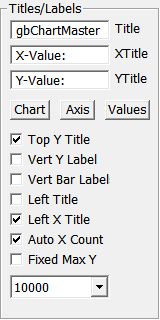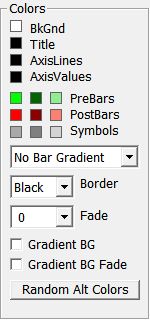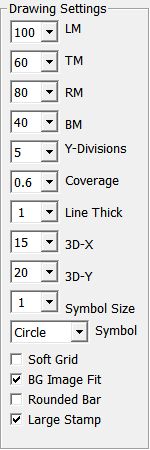 gbChartMaster
gbChartMaster
 gbChartMaster generates a variety of charts - bar charts (2D and 3D), stacked
bar charts, line charts, multi-line charts, points/symbols only and a hi-lo bar
chart. Control over all aspects of the graph elements - position, color, fonts, margins,
grid, and more - is provided. Images for background and for annotation stamps are also
supported.
gbChartMaster generates a variety of charts - bar charts (2D and 3D), stacked
bar charts, line charts, multi-line charts, points/symbols only and a hi-lo bar
chart. Control over all aspects of the graph elements - position, color, fonts, margins,
grid, and more - is provided. Images for background and for annotation stamps are also
supported.
While chart data is typically provided point by point by the user, gbChartMaster also allows the user to supply an equation which can be used to automatically generate the graph data.
The chart source code is written so that it can be easily inserted into PowerBASIC
applications, so that other programmers can add the graphing capabilities to their
own applications. The gbChartMaster application is essentially a demonstration of
how to use the include source code in a PowerBASIC application, including how to use all 100+
available settings!
To install, just unzip the contents of the distribution file into a folder of its own!

Feature List
The following features are available in gbChartMaster.
Data Sets
- 3 Independent Data Sets
- Limit Graph to a Range of Data Points in Each Data Set
Charts
- 9 Chart Types
- Over 100 Chart Settings
- Bar Charts (2D and 3D)
- Line and Point Charts
- Multi-Line Charts (2-Lines and 3-Lines)
- Stacked Bar Charts (2-Stacks and 3-Stacks)
- Hi-Lo Bar Charts
- Multiple Line Symbols (Point, Square, Rectangle, Circle)
- Real-Time Graph Updates as Application is Resized
- Real-Time Graph Updates as Settings Are Changed
- Optional Display of All Graph Elements
- Independent Margins for All Sides of the Charts
- Selection of Individual Bars Via Mouse
- Display of Bar/Point Data As Mouse Moves Over Graph Elements
Text/Colors/Font
- Graph Title, Axis Titles, Data Values and Data Set Labels
- Font/Color Control of All Graph Elements
- Data Labels (Displayed Above Points/Bars)
- Alternate Text for the X-Axis
- Graph/Axis Title Positioning
- Vertical/Horizontal Titles (Y-Axis and Bar Labels)
- Pivot Point for Alternating Chart Colors
- Multiple Gradient Options (Background and Bars)
- Color Fading
- Automatic X-Axis Value Display to Avoid Overlap of Bar Labels or X Axis Values
- Automatic Generation of Y-Axis Value Divisions (Optional)
- Line and Border Thickness/Color Control
Images
- Background Image Support
- Annotation - Images
- Annotation - Free-Style Drawing
- Fit Graph to Background Image
- Capture Chart Image to Clipboard
- Export Chart Image to JPG/GIF/PNG/BMP
- Save JPG Chart Image to Chart File Location
File Functions
- Automatically Save Session
- Save Chart to File
- Open Existing Chart Files
Other
- Automatic Generation of Data from User Equations
- Online Help
Chart Options
Here's a quick overview of the types of charts that are available in gbChartMaster:
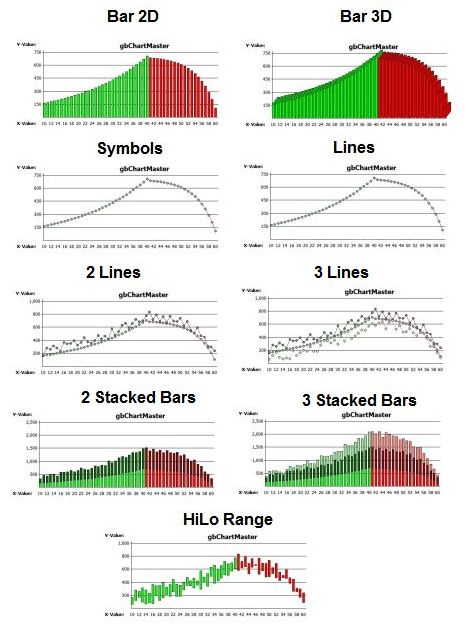
And, here are the bar gradient options.
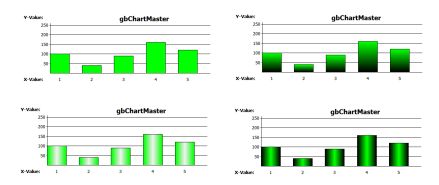
And, here are the image/graphics options.

Also, gbChartMaster allows the user to put in an equation of the form y = f(x)
and will generate the specified data points for the equation, as in this image:
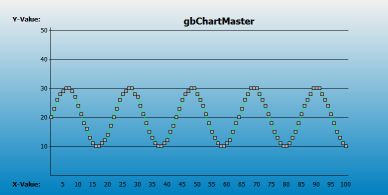
Using gbChartMaster
When gbChartMaster opens you will see a dialog with only the graph and
a status bar. Right mouse click the dialog (not over a bar), or use Ctrl-D to open
the Settings dialog.
As you resize the dialog the graph will resize accordingly.
As you move the mouse over the graph, information about the bar
under the mouse will be displayed in the statusbar. Point data is also available when
moving the mouse below the plotted point.
Some mouse actions of interest:
- Right click on a bar to select a bar
- Right click to open the Settings dialog (not over a bar)
- Double click anywhere to add stamp image
- Click in upper-left corner to remove last added stamp
- Double-click in upper-left corner to remove all stamps
- Double-click in upper-right corner to unselect all bars
- Double-click in lower-right corner to display the Settings Dialog
To make changes to the chart, call up the Settings dialog with Ctrl-D, or just
right click in an open area of the chart. When you close the graph dialog, the settings
dialog will also close.
When you make a change in the Settings Dialog, the graph will change immediately. Changes
are permanent, i.e., there is no "Save Changes" displayed when opening a new file or when
closing the Settings dialog.
Likewise, whenever you select a change on the Settings Dialog, there is no "Are You Sure?"
messages. So for such commands as "Reset", you'll want to look before you leap!
You'll want to experiment with the various settings to determine how to
get the graph that displays a graph the way you want it to look. See the section
above for several graph examples.
Settings Dialog
When the chart source code is used in a PowerBASIC application, the programmer
can utilize as many or as few of the possible settings as desired.
The following Settings dialog, from gbChartMaster, allows the user to modify all of
the available settings. Because of its complexity, it is likely that most applications would
include a subset of the gbChartMaster Settings dialog.
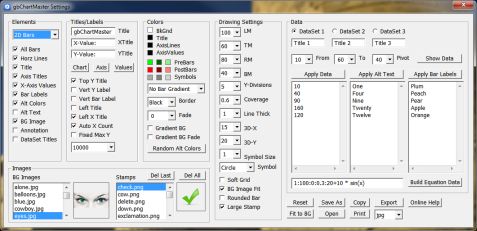
Each of the sections of the settings dialog is discussed below.
Elements:
Many of the graph elements are optional, as shown in the following image:
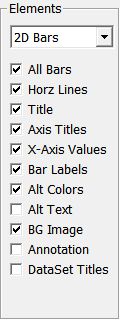
| |
For each of the 3 data sets supported by gbChartMaster, there are 9 chart types available for graphing the data:
- 2D Bars
- 3D Bars
- Symbols
- Line
- 2-Line
- 3-Line
- 2 Stacked Bars
- 3 Stacked Bars
- HiLo
The 2/3 Line/Stacked charts, and the HiLo chart, use data from more than one
data set to produce the chart.
|
Titles
Charts contain several kinds of text, some for the entire chart and some that are
specific to each independent data set.
|
| |
Text content, font and color of these text elements may be set by the user:
- Chart Title
- X/Y Axis Titles
- X/Y Axis Values
- Alternate Text
- Bar Labels
- Data Set Titles
The first 3 items in this list can be entered as seen in the image to the left. The remainder
of the text information can be entered independently for each data set - either programmatically or through the 'Data' section of the Settings dialog.
Options are available for location of all chart and axis titles. The Y axis title and the bar
labels can also be display vertically.
Fonts may also be selected, one each for the chart title, axis titles and axis values.
|
One important feature of gbChartMaster is its ability to manage how many data points
are shown. When the number of data points charted is too many, the X-axis text values can
overlap one another. The "Auto X Count" feature tells gbChartMaster to reduce the number
of axis values that are displayed. Even with that feature on, the full number of labels
can be shown (the "All Bars" selection from the elements image above).
gbChartMaster automatically detects the largest Y value to be graphed and selects a
maximum Y value and sets Y divisions to be shown on the Y axis. The user can override that
behavior with the "Fixed Max Y" to specify the maximum value to be shown on the
Y axis, as well as to set the number of Y divisions used on the Y axis.
Colors
gbChartMasters allows the selection of colors - text, background, bars, lines, symbols.
It also support gradients on the background and on the bars. The entire chart, including the background, can be faded to white. Border colors for bars can also be specified. The image to the left shows the full range of color, fade and gradient settings.
|
| |
gbChartMaster supports using a different color for each bar/line segment. The colors
can be assigned by setting the color for each point in a data set. Or, chart bar/line colors
can be specified in one of two ways. A 'pivot' point on the X-axis may be defined, where all
data to the left ('PreBars') is graphed in one color and all data to the right ('PostBars') is
graphed in a second color.
The border of the bars may be set (white/black/none), the entire bar can be faded to white
and the interior of each bar can be colored using one of the four gradient options.
|
Drawing
These features of the graph are independent of each data set.
|
| |
The graph-level settings
include the four margins, the number of divisions in the Y axis, width of the
bars, line thickness, 3D XY depth, symbol type and size, grid color, and the size of
an annotation stamp.
|
Data
For the single data set graphs (2D, 3D, line, symbols), the gbChartMaster can switch
between datasets. Each data set has it's own Title, From/To/Pivot points, equation and data
points. All of these can be edited in the 'Data' section.
The Apply Data, Apply Alt Text, and Apply Bar Labels buttons and corresponding textboxes are
pre-loaded with an alternate set of data for each data set. Pressing one of the buttons
replaces the corresponding data in the currently selected data set.
Pressing the 'Show Data' button will fill all 3 textboxes with the data from the currently
selected data set.
Manual changes to the textbox content is automatically saved, but not applied to the graph
until the 'Apply' buttons are pressed.
The Build Equation Data button fills the 'Data' textbox. The equation textbox consists of
5 parts:
- From X Point
- To X Point
- Starting X Value
- Incremental X Value Change With Each Point
- Equation
Images
An application can incorporate images into a graph.
gbChartMaster demonstrates approaches to using an image as a background and to using small images as 'stamps' to
be placed on the graph for annotation purposes.
Buttons
The buttons in this image are simply a collection of actions which the user may take.
Reset completely removes the current 3 data sets, replacing them with a set of default data.
There's no "Are you sure?", so be careful with it!
Charts may be saved to a file and later opened. The graph itself can be copied to the
clipboard or saved as a jpg file (saved to the same location as the graph file).
Resizing the gbChartMaster dialog can result in the background image being drawn at
other than its default aspect ratio. The 'Fit to BG' button will resize the height of the
gbChartMaster dialog to ensure that the image is drawn to the image's natural aspect ratio.
Background Images and Annotation Stamps
gbChartMaster ships with some sample background images and annotaion images,
kept in the 'bgimages' and 'stamps' subfolders. When the Settings dialog is opened
it reads those folders and populates the two image lists.
The background images can be of any type (BMP/JPG/PNG/GIF).
The annotation stamp images are all of the same size - 128x128 - and may be displayed
at full or half sized. Although any image type or size will work, small images with transparency (GIF/PNG) are best for overlaying on top of a graph.
Using gbChartMaster in PowerBASIC Applications
Only a few steps are needed to add chart features to your own PowerBASIC application.
- Use #Include to include the gbChartMaster include file
- Create a Graphic Control
- Create an array of type ChartData and a variable of type ChartSettings
- Initialize chart settings
As part of initialization, the main app passes the parent dialog handle, the
graphic control handle and the graphic control DC to the chart settings. Additionally,
initialization create the fonts needed by the gbChartMaster code.
The include file provides just two functions - DrawChart and DrawOneBar. It also
provides the 3 custom types used by gbChartMaster - ChartData, ChartSettings and
ChartPolyPoints. And finally, it provides some equates used by the two functions
and by the parent application.
In gbChartMaster, the required array/variable are defined as Global, but there's no requirement
for that from the code in the include file as the needed array/variable are passed to the
functions in the include file functions as arguments.
The use of Global variables in the non-include file code was done simply for my convenience in
writing the code.
The include file provides the minimum code needed to generate charts in your
own custom application. By itself, the include file does not provide image (background
and stamps) support. Example code for adding images to charts is provided in the
gbChartMaster main source code file. Image support requires the use of Jose's includes.
Without image support, the chart code does not require Jose's includes.
As now written, all chart X and Y values are LONG.
Keyboard Shortcuts
The following key combinations are available to the user to access gbChartMasterfeatures:
- F1 - Help
- Escape - Close the settings dialog
- Ctrl+B - Cycle through images in image folder
- Ctrl+D - Open Settings dialog
- Ctrl+E - Erase last stamp
- Ctrl+F - Cycle through graph types
- Ctrl+G - Display gradient colors in bars
- Ctrl+H - Open online Help page
- Ctrl+I - Toggle display of background image
- Ctrl+J - Automatically manage X-axis labels/bars to prevent overlap
- Ctrl+L - Toggle display of bar labels
- Ctrl+N - Reset all settings to default values
- Ctrl+O - Open new graph file
- Ctrl+Q - Cycle through chart files in charts folder
- Ctrl+R - Display Settings dialog next the main gbChartMaster graph
- Ctrl+S - Save graph to file (Save As)
- Ctrl+U - Unselect all bars
- Ctrl+W - Save JPG image of graph to same location as the chart file
- Ctrl+Y - Copy graph image to clipboard
Other Comments
Comments and suggestions are welcome!
 gbChartMaster generates a variety of charts - bar charts (2D and 3D), stacked
bar charts, line charts, multi-line charts, points/symbols only and a hi-lo bar
chart. Control over all aspects of the graph elements - position, color, fonts, margins,
grid, and more - is provided. Images for background and for annotation stamps are also
supported.
gbChartMaster generates a variety of charts - bar charts (2D and 3D), stacked
bar charts, line charts, multi-line charts, points/symbols only and a hi-lo bar
chart. Control over all aspects of the graph elements - position, color, fonts, margins,
grid, and more - is provided. Images for background and for annotation stamps are also
supported.
 gbChartMaster
gbChartMaster






